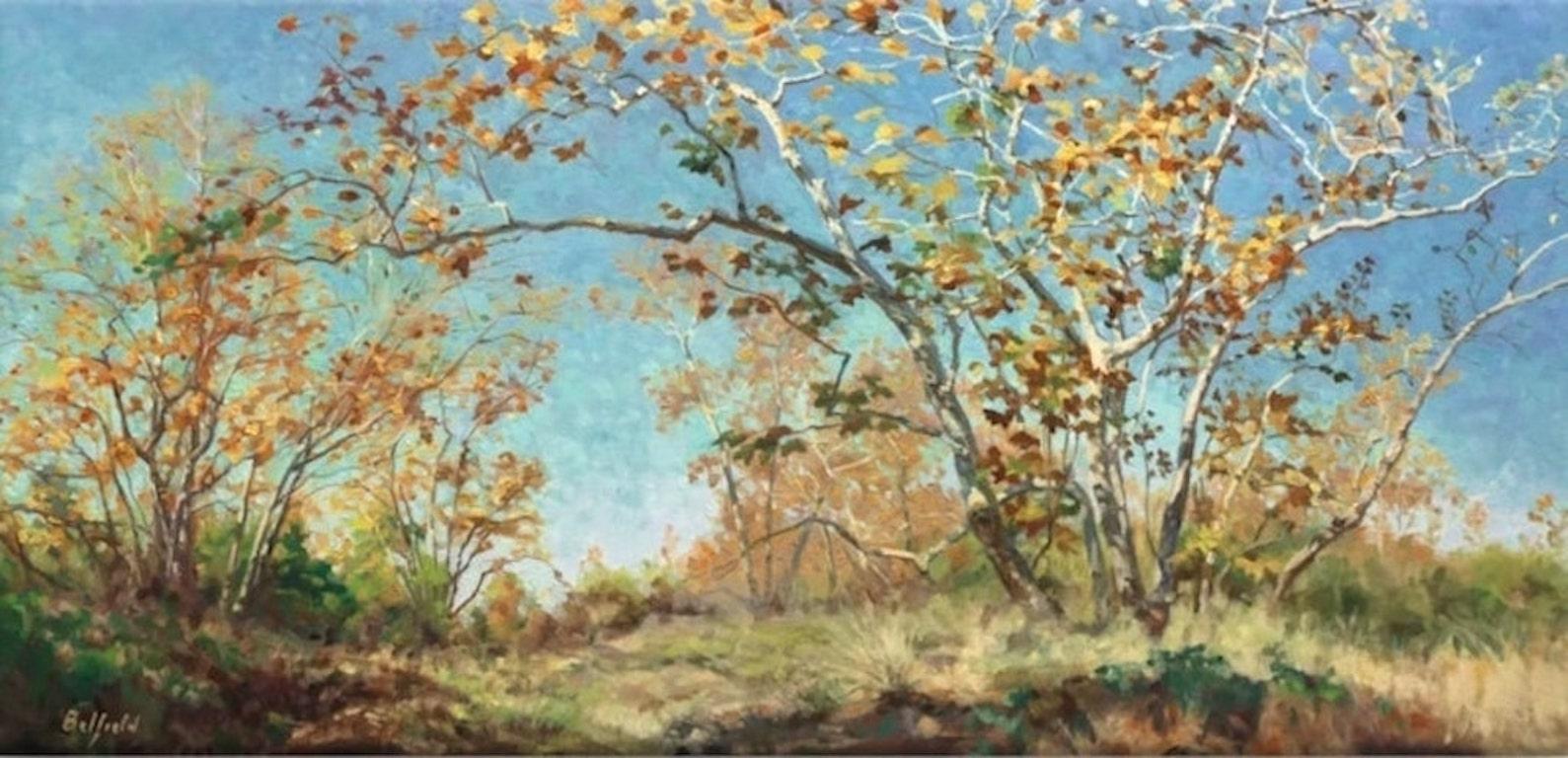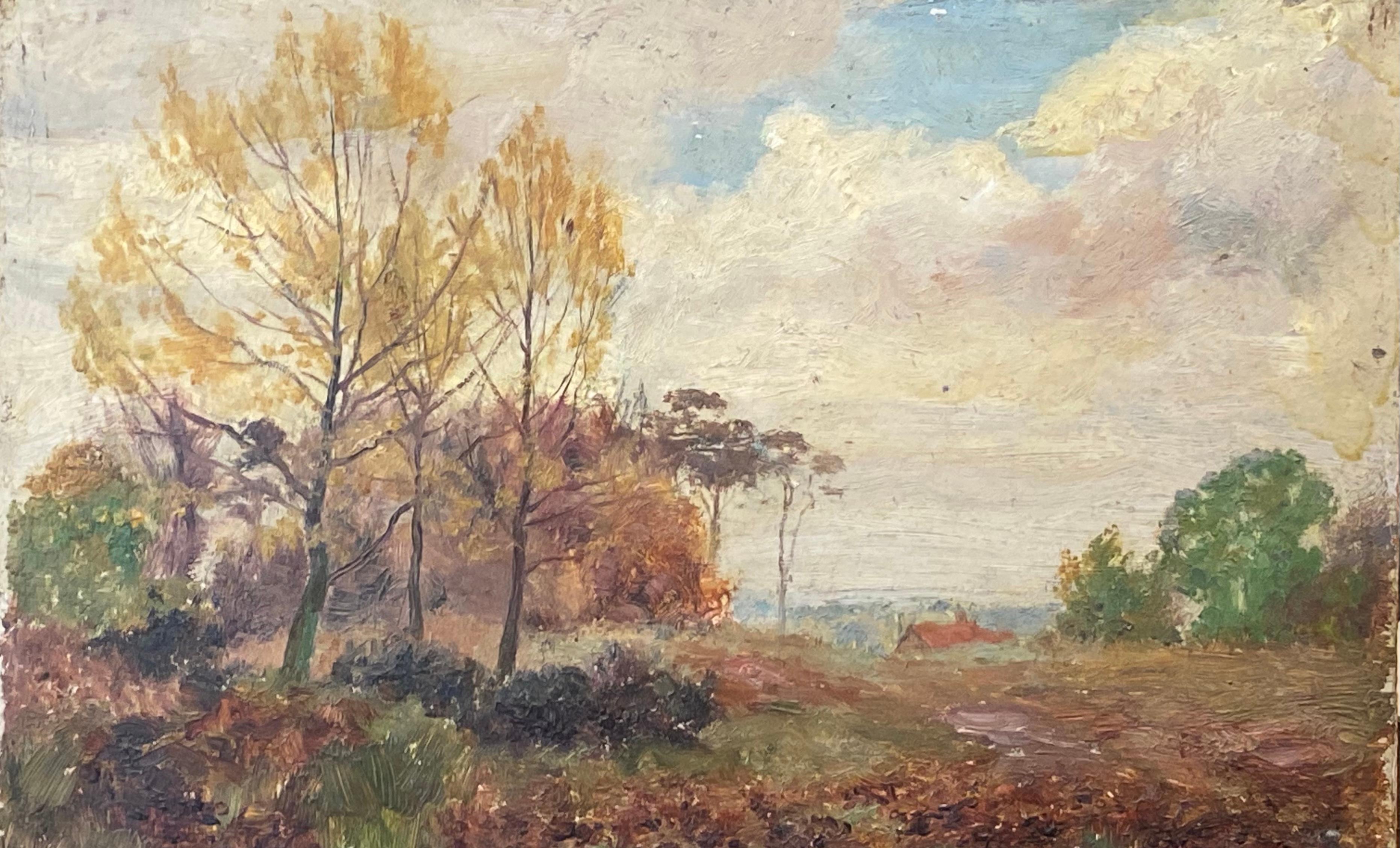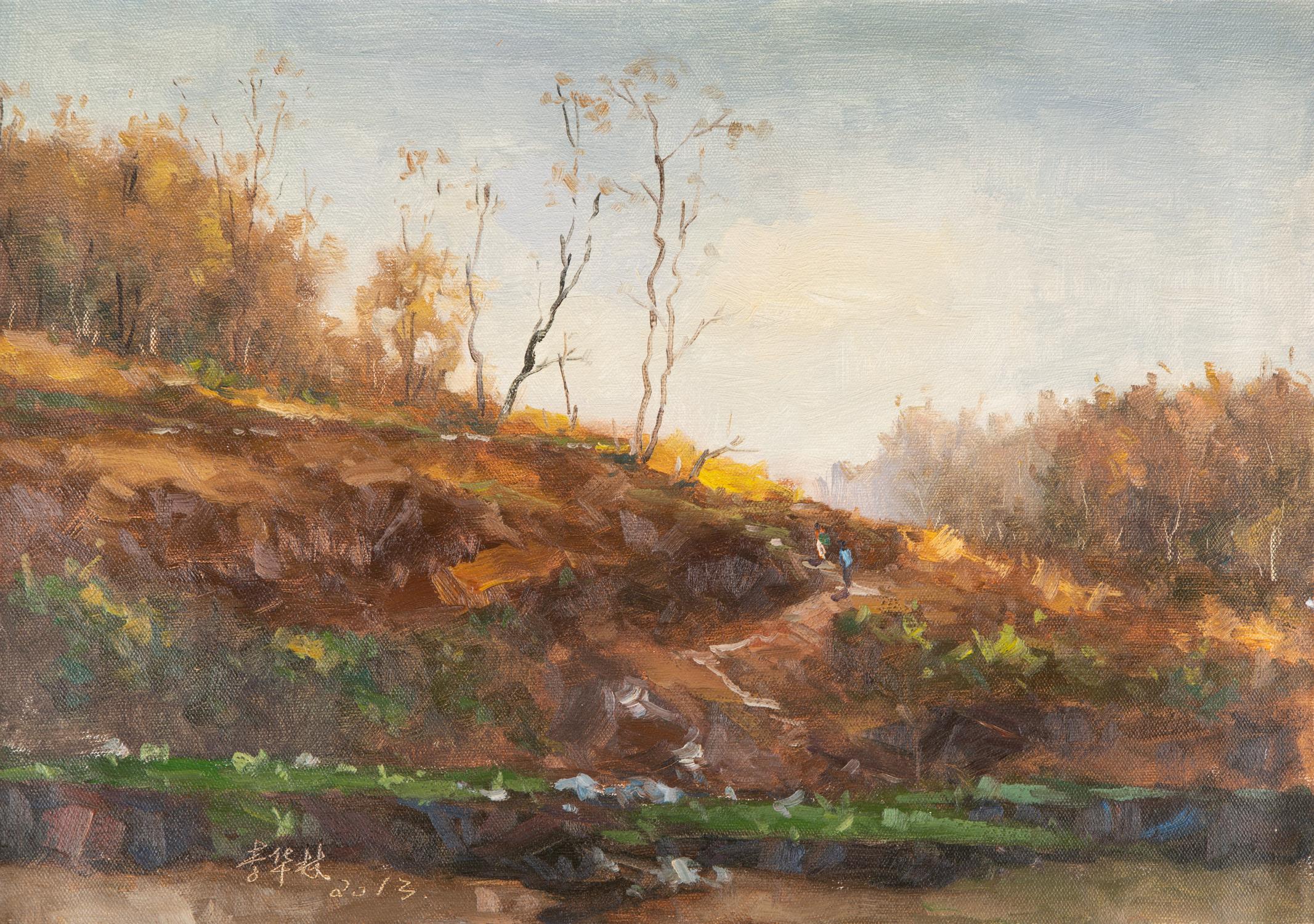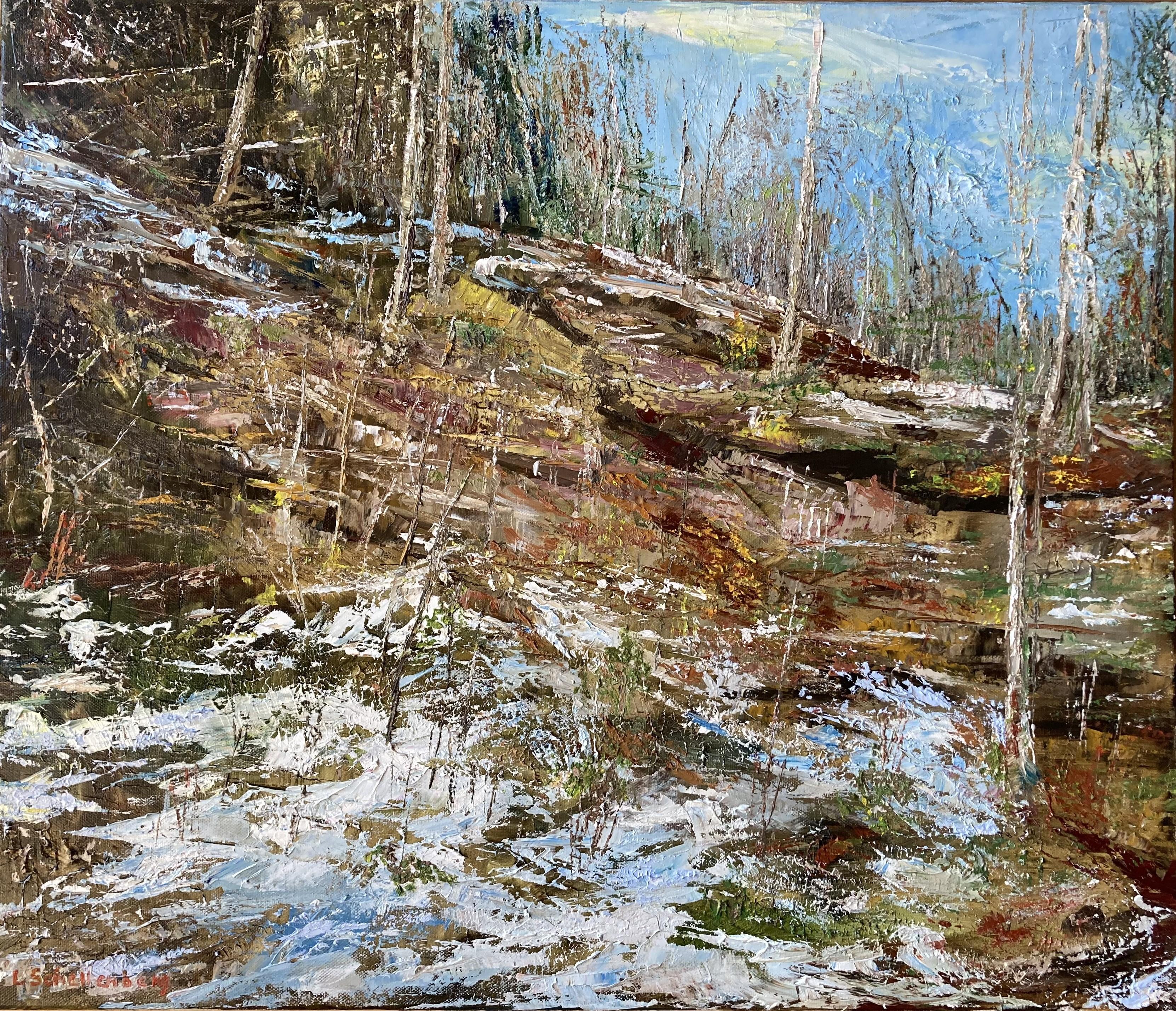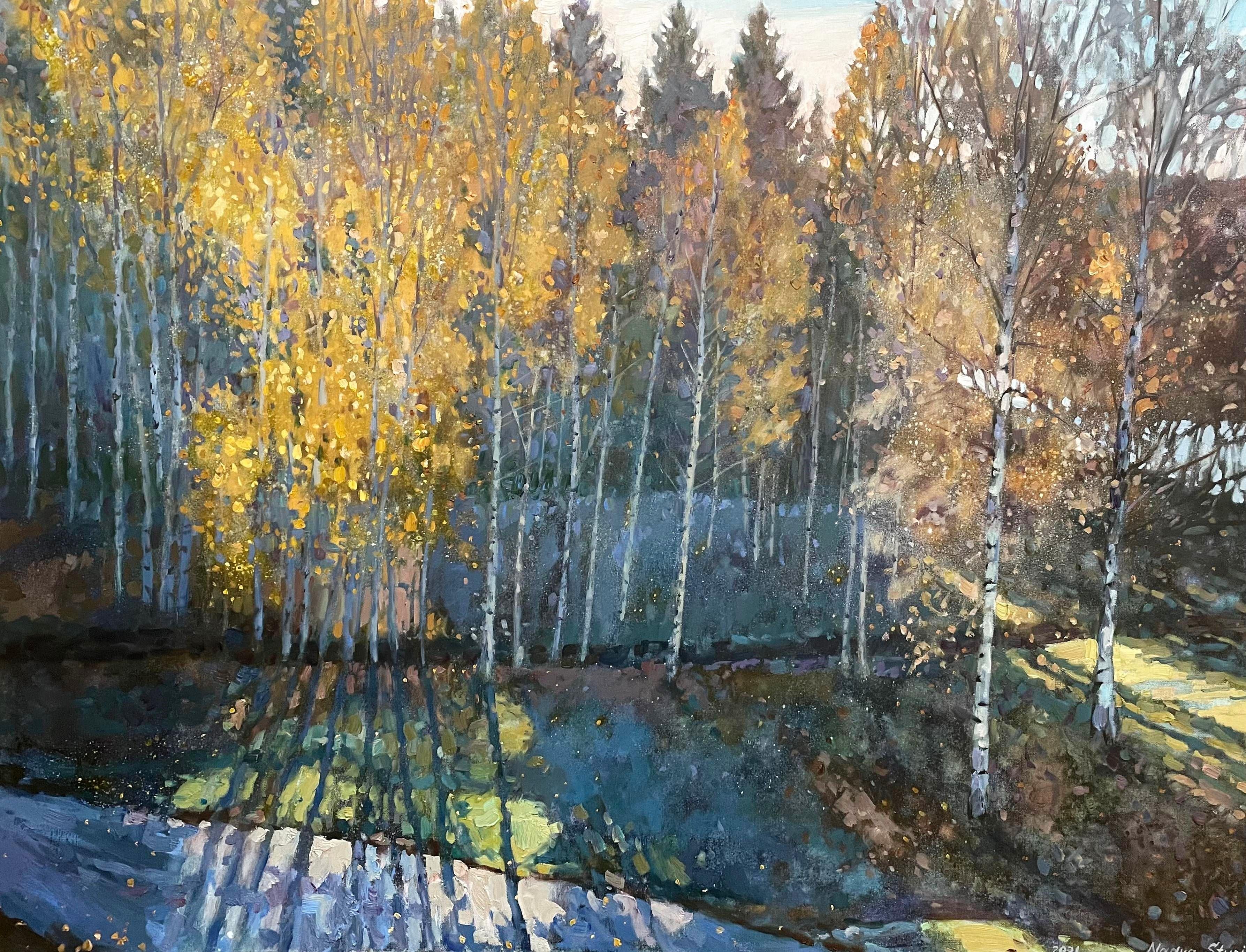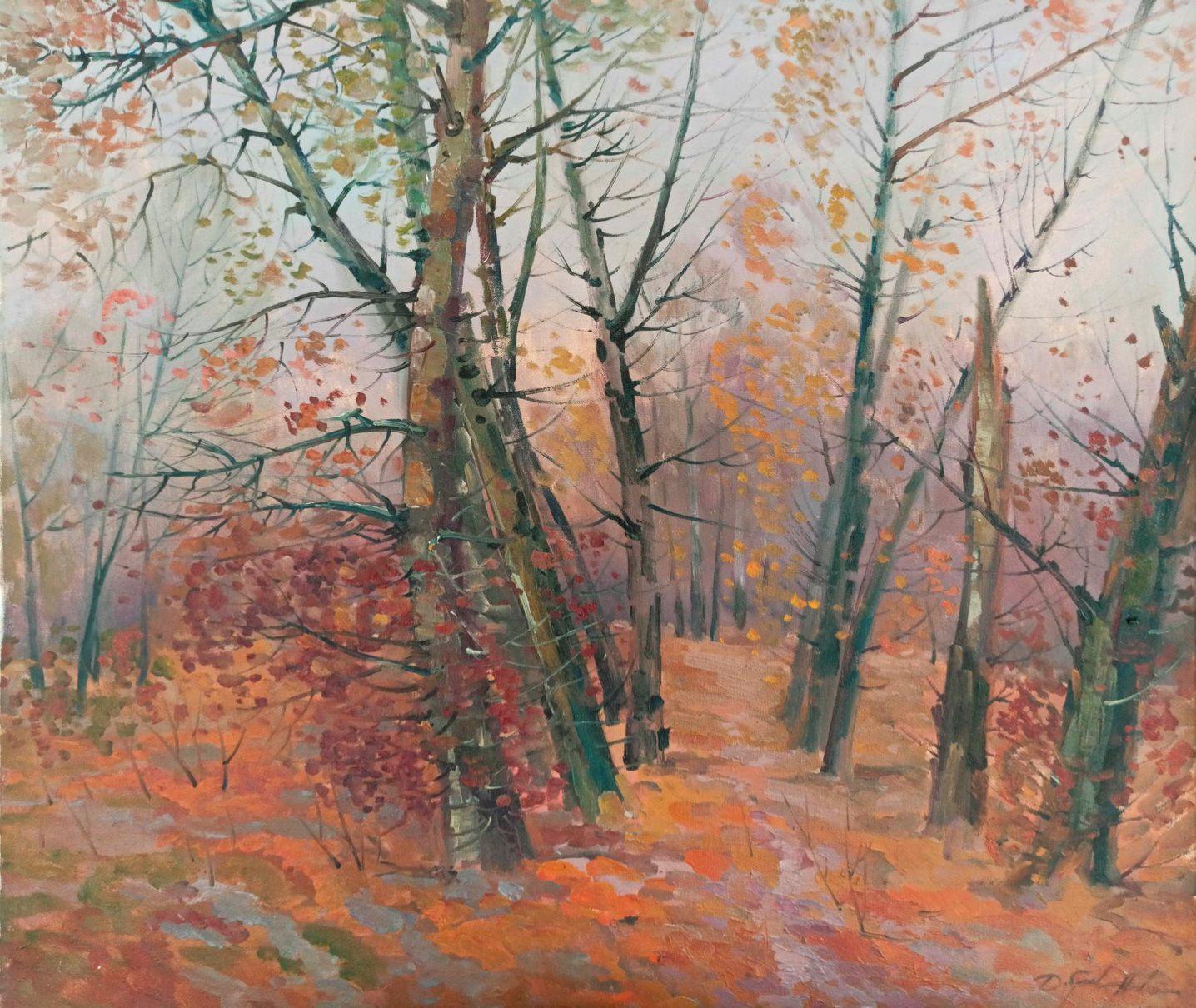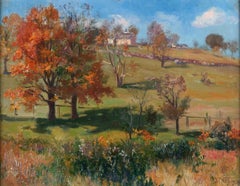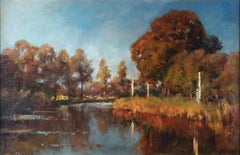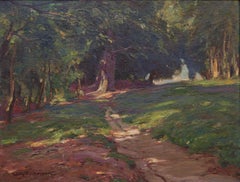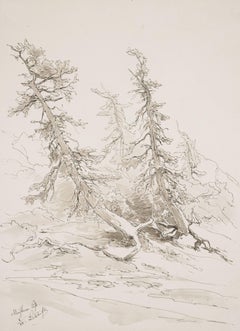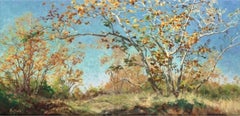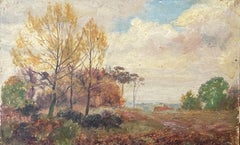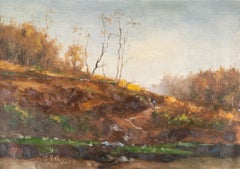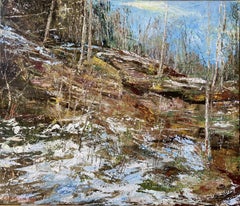Items Similar to Impressionist Autumn Landscape with Lake / - Diffuse Concretion -
Want more images or videos?
Request additional images or videos from the seller
1 of 9
Wilhelm FeldmannImpressionist Autumn Landscape with Lake / - Diffuse Concretion -c. 1905
c. 1905
$804.65
$1,005.8220% Off
£606.96
£758.6920% Off
€680
€85020% Off
CA$1,129.07
CA$1,411.3420% Off
A$1,231.23
A$1,539.0420% Off
CHF 646.80
CHF 808.5020% Off
MX$14,757.01
MX$18,446.2720% Off
NOK 8,202.02
NOK 10,252.5220% Off
SEK 7,632.75
SEK 9,540.9420% Off
DKK 5,180.43
DKK 6,475.5420% Off
About the Item
Wilhelm Feldmann (1859 Lüneburg - 1932 Lübeck), Impressionist autumn landscape with lake, around 1905. Pastel on cardboard, 46 cm x 31 cm (inside dimension), 52 cm x 37 cm (frame), signed “Wilh.[elm] Feldmann.” lower left. Framed behind glass.
- In good overall condition
- Diffuse Concretion -
Wilhelm Feldmann depicts the autumn landscape as an atmospheric impression of color from which nature becomes concrete. The bare branches in the middle ground appear almost sharply contoured, and above them the turquoise firs stand out against the sky. The autumnal leaves on the left unfold the dynamics of a crescendo of color that, although they form natural structures, appear as an independent event, while the lake disappears into the atmosphere and at the same time takes shape out of the diffuse. This oscillation between dissolution and presence of the natural motifs feeds the mysterious mood of the picture, which is intensified by the colorfulness and painterly effect of the pastel chalks.
About the artist
After beginning his art studies at the Munich Academy in 1878, he transferred to the Karlsruhe Art Academy in 1883, where he studied under Gustav Schönleber. From 1886 to 1900 he studied at the Berlin Art Academy, where he attended the master class of Eugen Bracht. Hans Meyer taught him etching and lithography. After completing his studies, Feldmann worked as a freelance artist in Berlin. In 1905 he moved to Mölln, where he ran an art school for women, who were banned from attending academies until 1918. In 1913 he finally moved to Lübeck. Feldmann devoted himself primarily to landscape painting. His lyrical, atmospheric paintings were highly regarded, and he was one of the most sought-after landscape painters of his time.
GERMAN VERSION
Wilhelm Feldmann (1859 Lüneburg - 1932 Lübeck), Impressionistische Herbstlandschaft mit See, um 1905. Pastell auf Malkarton, 46 cm x 31 cm (Innenmaß), 52 cm x 37 cm (Rahmen), links unten mit „Wilh.[elm] Feldmann.“ signiert. Hinter Glas gerahmt.
- in gutem Gesamtzustand
- Diffuse Konkretion -
Wilhelm Feldmann stellt die Herbstlandschaft als atmosphärischen Farbeindruck dar, aus dem sich die Natur heraus konkretisiert. Die kahlen Äste im Bildmittelgrund wirken beinahe konturenscharf und darüber zeichnen sich die türkisgrünen Tannen vor dem Himmel ab. Die herbstlich verfärbten Blätter am linken Bildrand hingegen entfalten die Dynamik eines Farbcrescendo, das sich zwar zu Naturstrukturen zusammenschließt, aber dennoch wie ein eigenständiges Geschehen wirkt, während der See im Atmosphärischen verschwindet und zugleich aus dem Diffusen heraus Gestalt annimmt. Aus diesem Oszillieren zwischen Auflösung und Präsenz der Naturmotive speist sich die von der Farbigkeit und der malerischen Wirkung der Pastellkreide verstärkte geheimnisvolle Stimmung des Bildes.
zum Künstler
Nach der Aufnahme des Kunststudiums an der Münchener Akademie im Jahre 1878, wechselte er 1883 an die Kunstakademie Karlsruhe und studierte dort bei Gustav Schönleber. Von 1886 bis 1900 war er dann an der Berliner Kunstakademie und besuchte dort die Meisterklasse von Eugen Bracht. Hans Meyer unterrichtete ihn in der Kunst der Radierung und der Lithographie. Nach dem Studium war Feldmann zunächst in Berlin als freischaffender Künstler tätig. 1905 erfolgte ein Umzug nach Mölln, wo er eine vorwiegend von Frauen besuchte Malerschule unterhielt, denen bis 1918 der Zugang zu den Akademien untersagt war. 1913 zog er schließlich nach Lübeck. Künstlerisch widmete sich Feldmann vor allem der Landschaft. Seine lyrischen Stimmungsbilder erfreuten sich einer großen Wertschätzung und er war einer der gefragtesten Heidemaler seiner Zeit.
- Creator:Wilhelm Feldmann (1859 - 1932, German)
- Creation Year:c. 1905
- Dimensions:Height: 18.12 in (46 cm)Width: 12.21 in (31 cm)Depth: 1.19 in (3 cm)
- Medium:
- Movement & Style:
- Period:
- Condition:
- Gallery Location:Berlin, DE
- Reference Number:1stDibs: LU2438215665752

About the Seller
5.0
Vetted Professional Seller
Every seller passes strict standards for authenticity and reliability
Established in 2014
1stDibs seller since 2023
22 sales on 1stDibs
- ShippingRetrieving quote...Shipping from: Berlin, Germany
- Return Policy
More From This Seller
View AllAutumn Landscape in Sunlight - Indian Summer -
Located in Berlin, DE
Frederick Vezin (1859 Torresdale Philadelphia - 1933 Düsseldorf), Autumn Landscape in the Sunlight, oil on canvas, mounted on cardboard, 32 x 41 cm (inside measurement), 44 x 51 cm (frame), signed and dates lower right "F. Vezin. [19]05".
- Cardboard slightly curved, small inconspicuous retouch at the centre of the upper edge of the picture.
About the artwork
Although the painting appears to be a sketch, Frederick Vezin considered it to be a finished work of art, as evidenced by his signature on the lower right. And it is precisely this sketchy quality that leads to an understanding of the painting, which was certainly created in the landscape itself: the natural phenomena were to be depicted artistically at the moment of their observation. This is not done by meticulously sketching nature, but - and here Vezin follows the teaching of French Impressionism - by illustrating nature in its visual fullness. The artist's eye is, as it were, immersed in the visuality of nature, which is made visible by his hand. The painting is therefore not a reflection of the landscape, but its artistic intensification.
This intensification also includes the fact that the foreground of the painting - corresponding to the field of vision - eludes a detail-oriented close-up view. Instead, the spatula-like application of paint, the vertical structure of which corresponds to the structure of the floral growth, has the effect of making nature tangible in its colourful substance.
At the same time, the foreground, which remains indeterminate in its concrete objectivity, creates an atmospheric space that connects with the actual protagonist of the picture, the group of trees, which flares up in shades of red and brown. Here, too, the leaves are more speckled than clearly outlined. It is precisely this 'sketchiness' that opens up a visual experience that makes the landscape accessible in its visual fullness, thus revealing its essence.
In addition to this abundance, the landscape is presented as a structure of order in that the composition of the picture makes the composition of the landscape visible. For example, the group of trees forms a distinct dark green shadow, which is repeated in the shadows cast by the trees behind it. A patterned diagonal axis is created in the picture, which is composed in this way by the landscape itself.
Strictly speaking, this is a cultivated landscape: a fence at the bottom and a low stone wall at the top, running from left to right, are two elements that also have a strong compositional effect. And on the top of the hill, a stone house is embedded in the landscape as the brightest surface in the picture. Nature and culture here form a harmonious synthesis, giving the painting an Arcadian touch.
In order to give the landscape as much space as possible, the horizon line is raised, but the design of the sky is also crucial. The clouds, combined with the shapes of the trees, create a bright blue sky. To the European eye, such a sky is reminiscent of a summer landscape. Accordingly, within the seasonal cycle, the blue sky is reserved for summer, and French Impressionism is also primarily an ode to summer. In Vezin's painting, however, the brilliant blue sky stands above an autumnal landscape, some of the trees even defoliated. It can therefore be assumed that the painting was made not in Europe but in the United States, and that it illustrates the proverbial Indian summer, making Frederick Vezin a pioneer of American landscape painting.
About the artist
Frederick Vezin was the son of a French immigrant to the United States and a German-born mother. This predestined him to promote artistic exchange between the old and new worlds. Having spent part of his schooling in Germany, in 1876, at the age of 20, he enrolled at the Düsseldorf Academy of Art, where he studied with Peter Janssen the Elder, Eduard von Gebhardt and Wilhelm Sohn, among others. He graduated in 1883, settled in Munich and returned to Düsseldorf in 1895, where he lived until his death in 1933.
A native of the United States, he travelled to the country frequently and became a popular portrait and society painter. His artistic talent, however, was most evident in his landscape paintings. Trained in French Impressionism, he developed a virtuoso use of colour and a free brushwork that remained tied to the landscape motif, opening up the landscape itself in a new way. Frederick Vezin turned his attention primarily to the landscape of his homeland, becoming a pioneer of modern American landscape...
Category
Early 1900s Impressionist Landscape Paintings
Materials
Oil, Cardboard
$2,080 Sale Price
20% Off
Late Summer River Landscape / - Realistic Impression -
By Jan Hillebrand Wijsmüller
Located in Berlin, DE
Jan Hillebrand Wijsmuller (1855 Amsterdam - 1925 ibid.), Late Summer River Landscape, oil on canvas, relined, 34 x 56 cm (inside measurement), 43 x 64 cm (frame), signed J[an] H[illebrand] Wijsmuller at lower right.
- in good condition, the frame with isolated bumped spots
- Realistic Impression -
About the artwork
The panoramic landscape format shows a river landscape, with the course of the river, which curves to the right, leading the eye into the depths of the picture and tempting it to continue the landscape in the imagination beyond the visible area. At the same time, however, the fact that the landscape is not visible through the bend in the river focuses our gaze on the entirety of the landscape depicted, without prompting us to focus on distant details. Accordingly, the brushstroke is not designed to render details with realistic precision. In the front left area of the river there is even a completely free brushwork, trained by Impressionism, which nevertheless remains committed to representational and convincingly suggests the movement of the water.
Regardless of the distance of the observer, the entire picture is painted with the same broad brushstroke, so that the landscape is given as an impression. And yet this impression is not ephemeral, as in the case of French Impressionism, to put it exaggeratedly, but reveals to us the essence of the landscape in all its richness. This is why the Dutch variant of Impressionism is always also a realism, although the pictures appear less progressive, but still contain a dimension of landscape painting that is lost with progress.
In the impression, the reality of the landscape is revealed, and this happens as we experience the landscape in the visual impression. Wijsmuller does not depict houses or people in order to allow the experience of the landscape to fully unfold. The experience is determined first and foremost by the river, which does not flow into the picture from our point of view, but towards us. Where the river begins to bend, the water is churned by a rapids. Toward us, the riverbed widens and the water comes to rest, covering the entire width of the foreground like a mirror.
The stillness of the water corresponds to the evening mood of the late summer landscape, in which the warm tones of the evening light blend with the yellow and brown tones of the plants. A gentle, almost idyllic reality, carried by the brushstroke, yet animated by a liveliness that is also made visible by the brushstroke. The broad, dynamically placed brushstrokes evoke the movement of the treetops and animate even the immobile reeds, while the trunks on the right bank, executed in virtuoso white strokes that seem like markings, make the sunlight shine. On the other bank, a carpet of light also spreads out, its energetic effect again expressed in the brushstroke. The dynamic of the landscape is further enhanced by the complementary color contrasts between the greens, yellows, and browns on the one hand and the blue of the all-encompassing sky on the other. A contrast that is intensified by the reflection in the water.
The evening coming to rest of the landscape is thus at the same time an all-encompassing contrasting and yet in itself harmonious movement. This reality becomes accessible to us as an experience in the impression of the landscape.
About the artist
Jan Hillebrand Wijsmuller entered the Royal Academy of Arts in Amsterdam in 1876 and studied under the innovative Professor August Allebé, who was famous for the Amsterdam Impressionism, also known as the Allebé School.
In 1877, Wijsmuller transferred to the Hague Academy of Art, and thus to the Hague School, and then completed his studies at the Brussels Academy of Art. Returning to the Netherlands, Wijsmuller opened his own studio in Amsterdam.
In 1883 he won the prestigious Young Artist Award, donated by Willink van Collen, which made Wijsmuller a well-known and sought-after artist.
Wijsmuller was a member of the Societät Arti et Amicitiae Amsterdam and the Pulchri Studio in The Hague.
Wijsmuller belongs to the second generation of the Hague School. While Vincent van Gogh described the protagonists of the first generation to his brother Theo as "the great gray people," the second generation, and Wijsmuller in particular, used a much more colorful palette. His oeuvre makes him a major player in Dutch Impressionism...
Category
1890s Impressionist Landscape Paintings
Materials
Canvas
$3,593 Sale Price
20% Off
Forest landscape bathed in sunlight / - The Monumentality of the Forest -
Located in Berlin, DE
Wilhelm Feldmann (1859 Lüneburg - 1932 Lübeck), Sunny forest landscape, c. 1900. Oil on canvas, marouflaged on wood, 37 cm x 48 cm (inside dimensions), 42.5 cm x 53.5 cm (frame), sig...
Category
Early 1900s Impressionist Landscape Paintings
Materials
Oil
Woodland / - The Inner Drama of the Landscape -
Located in Berlin, DE
Eduard Peithner von Lichtenfels (1833 Vienna - 1913 Berlin), Woodland, 1884. Watercolor and pen and ink on drawing paper, 30.4 cm x 22.5 cm, signed, dated and inscribed by the artist...
Category
1880s Landscape Drawings and Watercolors
Materials
Paper
$549 Sale Price
20% Off
Summer Forest Landscape, 1915 / - The Forest Walk -
Located in Berlin, DE
Stanislas Warnie (1879-1958), Summer Forest Landscape, 1915. Watercolor, 31.5 cm x 45 cm (passepartout), 50.5 cm x 63.5 cm (frame), signed "S. Warnie" at lower left and dated "1915"....
Category
1910s Art Nouveau Landscape Drawings and Watercolors
Materials
Watercolor
$614 Sale Price
20% Off
Plant Impression in Locarno - Floral Crescendo -
Located in Berlin, DE
Alexander Frenz (1861 Rheydt - 1941 Düsseldorf). Plant impression in Locarno. Gouache and watercolour. 35 x 23,5 cm (visible size), 49,5 x 38,5 cm (fra...
Category
1890s Impressionist Landscape Drawings and Watercolors
Materials
Watercolor
$870 Sale Price
20% Off
You May Also Like
Impressionist Landscape, "Forever Autumn"
Located in San Diego, CA
This is a one of a kind original impressionist landscape by San Diego artist, Brian Belfield. Its dimensions are 36x18. It is unframed. A certificate of authenticity follows delivery...
Category
2010s Impressionist Landscape Paintings
Materials
Oil
Impressionist Antique Painting - Autumnal Landscape
Located in Cirencester, Gloucestershire
Artist/ School: French School, early 20th century
Title: Hendon Fields
Medium: oil painting on board, unframed and inscribed verso
painting: 5.25 x 8.25inches
Provenance: privat...
Category
20th Century Impressionist Landscape Paintings
Materials
Oil
$708 Sale Price
30% Off
Hualin Li Contemporary Art Original Oil Painting "Autumn Countryside 2"
Located in New York, NY
Title: Autumn Countryside 2
Medium: Oil on canvas
Size: 19.5 x 27.5 inches
Frame: Framing options available!
Condition: The painting appears to be in excellent condition.
Note: ...
Category
21st Century and Contemporary Impressionist Landscape Paintings
Materials
Oil
$800 Sale Price
50% Off
Herbststimmung. Original painting
Located in Zofingen, AG
My heart's blood flows in this oil painting. It is a work full of passion that captures the change of seasons. The vibrant texture and richness of colors reflect the vitality and cha...
Category
2010s Impressionist Landscape Paintings
Materials
Canvas, Oil
Breath of Autumn . Large size landscape.Autumnal landscapes
Located in Oslo, NO
In this painting, I sought to capture the ephemeral beauty of light cascading through the trees, symbolizing life's fleeting moments. With both acrylic and oil, I embraced fine art a...
Category
2010s Impressionist Landscape Paintings
Materials
Oil, Acrylic
Autumn Forest, Landscape Impressionism Original oil Painting, Ready to Hang
Located in Granada Hills, CA
Artist: Peter Tovpev
Work: Original oil painting, handmade artwork, one of a kind
Medium: Oil on Canvas
Year: 2023
Style: Impressionism
Title: Autumn Forest
Size: 27.5" x 31.5" x 0...
Category
2010s Impressionist Landscape Paintings
Materials
Canvas, Oil
More Ways To Browse
Antique Concrete
Santa Barbara Plein Air Painting
Shirley Brown
Soho Paintings
Stormy Sea Painting
Sunset Mountains Oil
The Simpsons Art
Turkish Oil Paint
Vintage Winter Landscapes
Weather Oil Painting
White Egret
Yellow House Painting
17th Century Italian Landscape
1960 Spanish Oil Paintings
Alice Daughter
Antique Frames 18x24
Antique Sunrise Painting
B Murray
